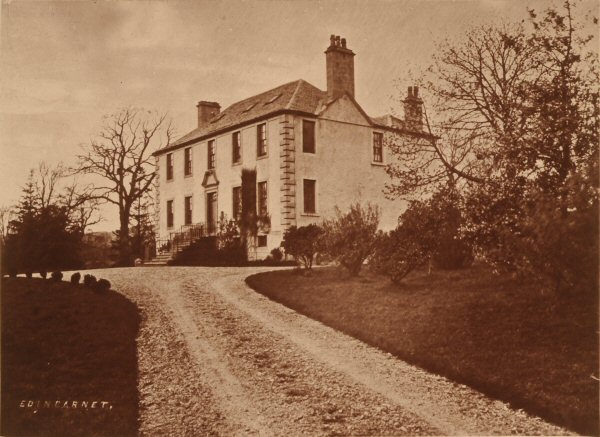

THE property of Walter Mackenzie, Esq., is situated in the parish of New Kilpatrick and county of Dumbarton.
The lands of "Edinbernan," along with a number of others, were confirmed to the Church of Kilpatrick by Alwin, Earl of Lennox, about the end of the twelfth century, and before 1227 the Church with all its endowments was granted by Maldoven, the succeeding Earl, to the abbey of Paisley. (1) The abbey lands were, in 1587, erected into a temporal lordship and granted to Lord Claud Hamilton, who was created Lord Paisley, and from him descend the present Abercorn family. In the Retour of the Earl of Abercorn, in 1621, Edinbarnet is included among the abbey lands, but at this time merely as a superiority.
Previous, however, to the distribution of the Church lands, Edinbarnet was in the possession of the Spreulls. This was a very old Dumbartonshire family. In 1294, "Walter Sprewl" was the steward of Malcolm, Earl of Lennox, and he obtained from him the lands of Dalmuir, (2) in the neighbourhood of Edinbarnet, and they continued in his family till the seventeenth century. At what time Edinbarnet became separated from the abbey lands, and how it came into the hands of the Spreulls does not appear, but we find that "Andrew Strieuling" of Law acquired it from Stephen Spreull in 1569. (3)
The Stirlings of Law and Edinbarnet are Cadets of Glorat. The lands of Law, which are adjacent to Edinbarnet, were acquired from Sir James Hamilton of Fynnart in 1528 by "William Strieuling" of Glorat. He was succeeded in Law by the eldest son of his second marriage,
Andrew Stirling, who acquired Edinbarnet as already shown, and the united estates descended in the male line to William Stirling, who succeeded in 1647.
William Stirling, great-grandson of Andrew Stirling, first of Law and Edinbarnet, married Margaret Maxwell of Dargarvel, and had three daughters. Margaret, the eldest, married James Buchanan of the Ross. (4) Mary, the second, and whose family eventually succeeded, married William Colquhoun of Craigton, before 1698. Agnes, the youngest, married, first, John Campbell of Succoth and had two sons, the second of whom succeeded his grandfather; she married, second, James Hamilton of Hutchison, by whom she had a son, James, who died without issue, and two daughters, Agnes and Ann, of whom afterwards. William Stirling died about the end of the century and was succeeded by his grandson,
John Campbell Stirling, who died in 1757, and was succeeded by his only son,
James Stirling, who died without issue in 1809, and was succeeded by his cousin,
Agnes Hamilton Stirling, the daughter of Agnes Stirling and James Hamilton. She married Peter Buchanan of Spittal, and died without issue in 1816; and was succeeded by her sister,
Anne Hamilton Stirling, who died unmarried the following year. The estate now reverted to the descendants of Mary Stirling, the second daughter of William Stirling and Margaret Maxwell, in the person of
William Colquhoun Stirling, M.D., H.E.I.C.S. He was the son of William Colquhoun of Kenmure. His sister, Margaret, married Alexander Dunlop of Keppoch, and her son Alexander was late laird of Edinbarnet. The great-grandmother of this William Colquhoun Stirling was Mary Stirling, as before shown; her daughter, Margaret Colquhoun, married Alan Colquhoun of Kenmure, who was the father of William Colquhoun of Kenmure. William Colquhoun Stirling married Helen, (5) youngest daughter of Archibald Calder, banker in Glasgow, and died in 1842, when his only son,
William Colquhoun Stirling, H.E.I.C.S., succeeded. He married Miss Macleod, and died without issue in 1866, and the estate then passed to his cousin,
Alexander Colquhoun Stirling Murray-Dunlop of Law, Edinbarnet and Corsock, late M.P. for Greenock. On the death of this gentleman, the estate was sold to the present proprietor. (6)
In 1618 the family residence seems to have been at Law, as we find a charter dated there, but it was afterwards removed to Edinbarnet, where the first house was built by William Stirling about 1644. There is an old stone on the wall of the coach-house with the initials,
W S
M M
1644.
This was three years after William Stirling's marriage with Margaret Maxwell, and three years before he succeeded his father. The present house was built in 1758, and on a stone is incised the family motto, HIC FIDES ET ROBUR, and the date 1758. (7)
(1) Chartulary of Paisley.
(2) Chartulary of Lennox.
(3) Charter at Edinbarnet, dated 13th July 1569.
(4) In the privately printed book "The Stirlings of Keir," from which we have largely drawn in this account of the Law family, we find that this marriage displeased her father so much that she was disinherited, and her second sister was also passed over in the first instance.
(5) This lady still survives; she is a lineal descendant of the Calders of Inchbreck : her brother, Mr. John Calder, is a well known citizen of Glasgow.
(6) This gentleman, who is a brother of Mr. M'Kenzie of Caldarvon in Kilmaronock parish, in another part of this county, is a well known and deservedly popular citizen of Glasgow.
(7) The roof-tree of this house is said to be the identical oaken beam which formed the roof-tree of the old dwelling house at Mugdock Castle.
Back to Contents